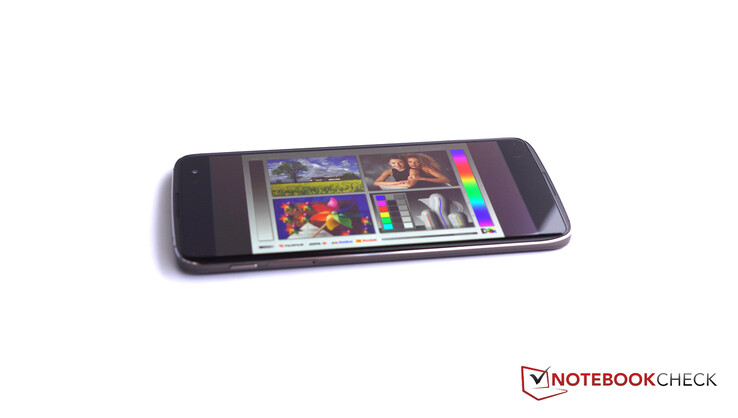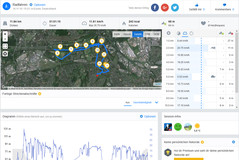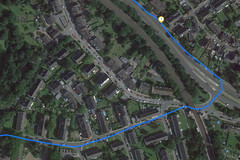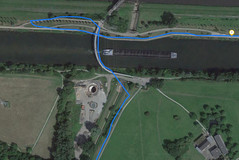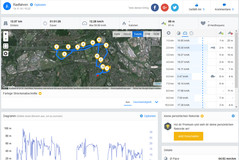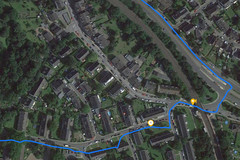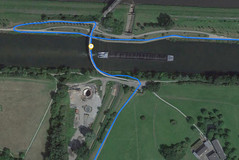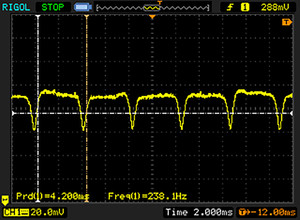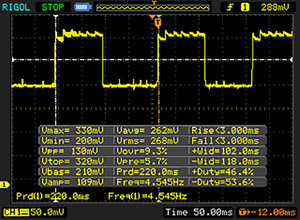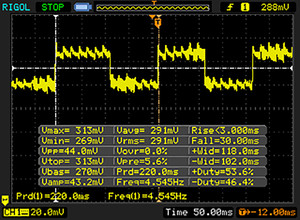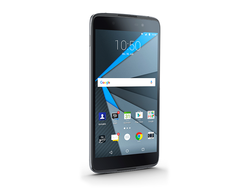Breve análisis del Smartphone BlackBerry DTEK60
Top 10 Análisis
» Top 10 Portátiles Multimedia
» Top 10 Portátiles de Juego
» Top 10 Portátiles de Juego ligeros
» Top 10 Portátiles Asequibles de Oficina/Empresa
» Top 10 Portátiles de Juego Ligeros
» Top 10 Portátiles de Oficina/Empresa Premium
» Top 10 Estaciones de Trabajo
» Top 10 Subportátiles
» Top 10 Ultrabooks
» Top 10 Convertibles
» Top 10 Tablets
» Top 10 Tablets Windows
» Top 10 Tablets de menos de 250 Euros
» Top 10 Phablets (>5.5")
» Top 10 Smartphones
» Top 10 Smartphones (≤5")
» Top 10 Smartphones de menos de 300 Euros
» Top 10 Smartphones de menos de 120 Euros
» Top 10 Portátiles de menos de 1000 Euros
» Top 10 Portátiles de menos de 500 Euros
» Top 10 Portátiles de menos de 300 Euros
» Los Mejores Displays de Portátiles Analizados por Notebookcheck
| Networking | |
| iperf3 transmit AX12 | |
| Google Pixel XL 2016 | |
| Samsung Galaxy S7 Edge | |
| OnePlus 3 | |
| BlackBerry DTEK60 | |
| iperf3 receive AX12 | |
| Google Pixel XL 2016 | |
| OnePlus 3 | |
| BlackBerry DTEK60 | |
| Samsung Galaxy S7 Edge | |
| |||||||||||||||||||||||||
iluminación: 88 %
Brillo con batería: 590 cd/m²
Contraste: ∞:1 (Negro: 0 cd/m²)
ΔE ColorChecker Calman: 6.6 | ∀{0.5-29.43 Ø4.78}
ΔE Greyscale Calman: 4.3 | ∀{0.09-98 Ø5}
Gamma: 1.88
CCT: 6966 K
| BlackBerry DTEK60 AMOLED, 2560x1440, 5.5" | Google Pixel XL 2016 AMOLED, 2560x1440, 5.5" | OnePlus 3 Optic-AMOLED, 1920x1080, 5.5" | Apple iPhone 7 Plus IPS, 1920x1080, 5.5" | Huawei P9 Plus AMOLED, 1920x1080, 5.5" | Samsung Galaxy S7 Edge Super AMOLED, 2560x1440, 5.5" | |
|---|---|---|---|---|---|---|
| Screen | 4% | 2% | 37% | -9% | 34% | |
| Brightness middle (cd/m²) | 590 | 402 -32% | 419 -29% | 557 -6% | 361 -39% | 554 -6% |
| Brightness (cd/m²) | 608 | 408 -33% | 431 -29% | 553 -9% | 366 -40% | 552 -9% |
| Brightness Distribution (%) | 88 | 85 -3% | 84 -5% | 97 10% | 87 -1% | 96 9% |
| Black Level * (cd/m²) | 0.35 | |||||
| Colorchecker dE 2000 * | 6.6 | 4 39% | 4.1 38% | 1.4 79% | 5.1 23% | 1.59 76% |
| Colorchecker dE 2000 max. * | 14.3 | 10.1 29% | 12 16% | 3.1 78% | 10 30% | 2.56 82% |
| Greyscale dE 2000 * | 4.3 | 3.2 26% | 3.3 23% | 1.3 70% | 5.5 -28% | 2.01 53% |
| Gamma | 1.88 117% | 2.19 100% | 2.1 105% | 2.21 100% | 2.24 98% | 2.01 109% |
| CCT | 6966 93% | 7037 92% | 6550 99% | 6667 97% | 7388 88% | 6321 103% |
| Color Space (Percent of AdobeRGB 1998) (%) | 89.38 | 63.1 | 82.12 | |||
| Color Space (Percent of sRGB) (%) | 100 | 99.83 | 99.98 | |||
| Contrast (:1) | 1591 |
* ... más pequeño es mejor
Parpadeo de Pantalla / PWM (Pulse-Width Modulation)
| Parpadeo de Pantalla / PWM detectado | 238.1 Hz | ≤ 100 % de brillo | |
La retroiluminación del display parpadea a 238.1 Hz (seguramente usa PWM - Pulse-Width Modulation) a un brillo del 100 % e inferior. Sobre este nivel de brillo no debería darse parpadeo / PWM. La frecuencia de 238.1 Hz es relativamente baja, por lo que la gente sensible debería ver parpadeos y padecer fatiga visual por la pantalla (usado al brillo indicado a continuación). Comparación: 53 % de todos los dispositivos testados no usaron PWM para atenuar el display. Si se usó, medimos una media de 8095 (mínimo: 5 - máxmo: 343500) Hz. | |||
Tiempos de respuesta del display
| ↔ Tiempo de respuesta de Negro a Blanco | ||
|---|---|---|
| 6 ms ... subida ↗ y bajada ↘ combinada | ↗ 3 ms subida | |
| ↘ 3 ms bajada | ||
| La pantalla mostró tiempos de respuesta muy rápidos en nuestros tests y debería ser adecuada para juegos frenéticos. En comparación, todos los dispositivos de prueba van de ##min### (mínimo) a 240 (máximo) ms. » 17 % de todos los dispositivos son mejores. Esto quiere decir que el tiempo de respuesta medido es mejor que la media (20.2 ms) de todos los dispositivos testados. | ||
| ↔ Tiempo de respuesta 50% Gris a 80% Gris | ||
| 33 ms ... subida ↗ y bajada ↘ combinada | ↗ 3 ms subida | |
| ↘ 30 ms bajada | ||
| La pantalla mostró tiempos de respuesta lentos en nuestros tests y podría ser demasiado lenta para los jugones. En comparación, todos los dispositivos de prueba van de ##min### (mínimo) a 636 (máximo) ms. » 44 % de todos los dispositivos son mejores. Eso quiere decir que el tiempo de respuesta es similar al dispositivo testado medio (31.6 ms). | ||
| AnTuTu v6 - Total Score (ordenar por valor) | |
| BlackBerry DTEK60 | |
| Google Pixel XL 2016 | |
| OnePlus 3 | |
| Apple iPhone 7 Plus | |
| Huawei P9 Plus | |
| Samsung Galaxy S7 Edge | |
| Geekbench 4.0 | |
| 64 Bit Single-Core Score (ordenar por valor) | |
| BlackBerry DTEK60 | |
| Google Pixel XL 2016 | |
| OnePlus 3 | |
| Apple iPhone 7 Plus | |
| Samsung Galaxy S7 Edge | |
| 64 Bit Multi-Core Score (ordenar por valor) | |
| BlackBerry DTEK60 | |
| Google Pixel XL 2016 | |
| OnePlus 3 | |
| Apple iPhone 7 Plus | |
| Samsung Galaxy S7 Edge | |
| PCMark for Android - Work performance score (ordenar por valor) | |
| BlackBerry DTEK60 | |
| Google Pixel XL 2016 | |
| OnePlus 3 | |
| Huawei P9 Plus | |
| Samsung Galaxy S7 Edge | |
| Octane V2 - Total Score (ordenar por valor) | |
| BlackBerry DTEK60 | |
| Google Pixel XL 2016 | |
| OnePlus 3 | |
| Apple iPhone 7 Plus | |
| Huawei P9 Plus | |
| Samsung Galaxy S7 Edge | |
| Mozilla Kraken 1.1 - Total (ordenar por valor) | |
| BlackBerry DTEK60 | |
| Google Pixel XL 2016 | |
| OnePlus 3 | |
| Apple iPhone 7 Plus | |
| Huawei P9 Plus | |
| Samsung Galaxy S7 Edge | |
| WebXPRT 2015 - Overall (ordenar por valor) | |
| BlackBerry DTEK60 | |
| Google Pixel XL 2016 | |
| OnePlus 3 | |
| Apple iPhone 7 Plus | |
| Huawei P9 Plus | |
| Samsung Galaxy S7 Edge | |
| JetStream 1.1 - Total Score (ordenar por valor) | |
| BlackBerry DTEK60 | |
| Google Pixel XL 2016 | |
| OnePlus 3 | |
| Apple iPhone 7 Plus | |
| Huawei P9 Plus | |
| Samsung Galaxy S7 Edge | |
* ... más pequeño es mejor
| AndroBench 3-5 | |
| Sequential Read 256KB (ordenar por valor) | |
| BlackBerry DTEK60 | |
| Google Pixel XL 2016 | |
| OnePlus 3 | |
| Huawei P9 Plus | |
| Samsung Galaxy S7 Edge | |
| Sequential Write 256KB (ordenar por valor) | |
| BlackBerry DTEK60 | |
| Google Pixel XL 2016 | |
| OnePlus 3 | |
| Huawei P9 Plus | |
| Samsung Galaxy S7 Edge | |
| Random Read 4KB (ordenar por valor) | |
| BlackBerry DTEK60 | |
| Google Pixel XL 2016 | |
| OnePlus 3 | |
| Huawei P9 Plus | |
| Samsung Galaxy S7 Edge | |
| Random Write 4KB (ordenar por valor) | |
| BlackBerry DTEK60 | |
| Google Pixel XL 2016 | |
| OnePlus 3 | |
| Huawei P9 Plus | |
| Samsung Galaxy S7 Edge | |
| Sequential Read 256KB SDCard (ordenar por valor) | |
| BlackBerry DTEK60 | |
| Huawei P9 Plus | |
| Samsung Galaxy S7 Edge | |
| Sequential Write 256KB SDCard (ordenar por valor) | |
| BlackBerry DTEK60 | |
| Huawei P9 Plus | |
| Samsung Galaxy S7 Edge | |
(±) La temperatura máxima en la parte superior es de 42.6 °C / 109 F, frente a la media de 35.2 °C / 95 F, que oscila entre 21.9 y 247 °C para la clase Smartphone.
(±) El fondo se calienta hasta un máximo de 42.5 °C / 109 F, frente a la media de 34 °C / 93 F
(+) En reposo, la temperatura media de la parte superior es de 28.4 °C / 83# F, frente a la media del dispositivo de 32.9 °C / 91 F.
BlackBerry DTEK60 análisis de audio
(+) | los altavoces pueden reproducir a un volumen relativamente alto (#84.4 dB)
Graves 100 - 315 Hz
(-) | casi sin bajos - de media 21.5% inferior a la mediana
(±) | la linealidad de los graves es media (8.6% delta a frecuencia anterior)
Medios 400 - 2000 Hz
(±) | medias más altas - de media 5.4% más altas que la mediana
(+) | los medios son lineales (5.8% delta a la frecuencia anterior)
Altos 2 - 16 kHz
(±) | máximos más altos - de media 6.5% más altos que la mediana
(+) | los máximos son lineales (5.2% delta a la frecuencia anterior)
Total 100 - 16.000 Hz
(±) | la linealidad del sonido global es media (22% de diferencia con la mediana)
En comparación con la misma clase
» 45% de todos los dispositivos probados de esta clase eran mejores, 7% similares, 48% peores
» El mejor tuvo un delta de 11%, la media fue 35%, el peor fue ###max##%
En comparación con todos los dispositivos probados
» 63% de todos los dispositivos probados eran mejores, 6% similares, 31% peores
» El mejor tuvo un delta de 4%, la media fue 24%, el peor fue ###max##%
OnePlus 3 análisis de audio
(+) | los altavoces pueden reproducir a un volumen relativamente alto (#88.6 dB)
Graves 100 - 315 Hz
(-) | casi sin bajos - de media 30.9% inferior a la mediana
(±) | la linealidad de los graves es media (11.3% delta a frecuencia anterior)
Medios 400 - 2000 Hz
(+) | medios equilibrados - a sólo 4.2% de la mediana
(+) | los medios son lineales (4.9% delta a la frecuencia anterior)
Altos 2 - 16 kHz
(±) | máximos más altos - de media 5.6% más altos que la mediana
(+) | los máximos son lineales (3.2% delta a la frecuencia anterior)
Total 100 - 16.000 Hz
(±) | la linealidad del sonido global es media (21.8% de diferencia con la mediana)
En comparación con la misma clase
» 44% de todos los dispositivos probados de esta clase eran mejores, 8% similares, 48% peores
» El mejor tuvo un delta de 11%, la media fue 35%, el peor fue ###max##%
En comparación con todos los dispositivos probados
» 61% de todos los dispositivos probados eran mejores, 7% similares, 32% peores
» El mejor tuvo un delta de 4%, la media fue 24%, el peor fue ###max##%
Apple iPhone 7 Plus análisis de audio
(±) | la sonoridad del altavoz es media pero buena (81.4 dB)
Graves 100 - 315 Hz
(-) | casi sin bajos - de media 24.1% inferior a la mediana
(±) | la linealidad de los graves es media (7.4% delta a frecuencia anterior)
Medios 400 - 2000 Hz
(+) | medios equilibrados - a sólo 4.7% de la mediana
(±) | la linealidad de los medios es media (7.6% delta respecto a la frecuencia anterior)
Altos 2 - 16 kHz
(+) | máximos equilibrados - a sólo 4.3% de la mediana
(+) | los máximos son lineales (6.9% delta a la frecuencia anterior)
Total 100 - 16.000 Hz
(±) | la linealidad del sonido global es media (22% de diferencia con la mediana)
En comparación con la misma clase
» 45% de todos los dispositivos probados de esta clase eran mejores, 7% similares, 48% peores
» El mejor tuvo un delta de 11%, la media fue 35%, el peor fue ###max##%
En comparación con todos los dispositivos probados
» 63% de todos los dispositivos probados eran mejores, 6% similares, 31% peores
» El mejor tuvo un delta de 4%, la media fue 24%, el peor fue ###max##%
| Off / Standby | |
| Ocioso | |
| Carga |
|
Clave:
min: | |
| BlackBerry DTEK60 3000 mAh | Google Pixel XL 2016 3450 mAh | OnePlus 3 3000 mAh | Apple iPhone 7 Plus 2915 mAh | Huawei P9 Plus 3400 mAh | Samsung Galaxy S7 Edge 3600 mAh | |
|---|---|---|---|---|---|---|
| Power Consumption | 17% | -1% | -28% | 7% | 5% | |
| Idle Minimum * (Watt) | 0.7 | 0.53 24% | 0.57 19% | 0.77 -10% | 0.87 -24% | 0.63 10% |
| Idle Average * (Watt) | 1.13 | 1.07 5% | 1.24 -10% | 2.04 -81% | 1.2 -6% | 1.1 3% |
| Idle Maximum * (Watt) | 1.2 | 1.12 7% | 1.36 -13% | 2.24 -87% | 1.27 -6% | 1.56 -30% |
| Load Average * (Watt) | 6.52 | 5.53 15% | 5.92 9% | 4.69 28% | 4.69 28% | 5.95 9% |
| Load Maximum * (Watt) | 9.75 | 6.26 36% | 10.53 -8% | 8.66 11% | 5.63 42% | 6.7 31% |
* ... más pequeño es mejor
| BlackBerry DTEK60 3000 mAh | Google Pixel XL 2016 3450 mAh | OnePlus 3 3000 mAh | Apple iPhone 7 Plus 2915 mAh | Huawei P9 Plus 3400 mAh | Samsung Galaxy S7 Edge 3600 mAh | |
|---|---|---|---|---|---|---|
| Duración de Batería | -17% | 9% | 4% | -2% | 28% | |
| Reader / Idle (h) | 22.6 | 22.2 -2% | 22.3 -1% | 30.6 35% | 24.1 7% | 27.7 23% |
| H.264 (h) | 13.5 | 8.4 -38% | 14.1 4% | 13.6 1% | 12.9 -4% | 15.2 13% |
| WiFi v1.3 (h) | 13 | 8.4 -35% | 14 8% | 9.8 -25% | 8.8 -32% | 12.2 -6% |
| Load (h) | 3.6 | 3.8 6% | 4.5 25% | 3.8 6% | 4.4 22% | 6.5 81% |
Pro
Contra
Aprendiendo de sus recientes errores, BlackBerry presenta el nuevo DTEK60, que ofrece un smartphone más que adecuado a un precio razonable. La característica principal del producto son sus mejoras de seguridad, algo crucial en la era de los cyberataques para empresas y usuarios domésticos por igual.
Que la empresa haya hecho la transición a Android - optando por no usar más su SO propietario - puede decepcionar a fans y puristas, pero es un movimiento completamente razonable, particularmente a la vista del rápido decline de la rama en cuota de mercado. BlackBerry cambia poco al SO nativo, ofreciendo poco bloatware y algunas mejoras bien implementadas.
El teléfono en sí ofrece un rendimiento incuestionablemente de primera, una carcasa sólida y atractiva, y un volumen de altavoz impresionante. Lo que es más, el aguante de batería es absolutamente adecuado para el uso diario, las cámaras producen fotos de calidad, y el brillantísimo display AMOLED con su notable cobertura de espectro de color es un auténtico punto fuerte.
Por otro lado, tanto el acceso a la memoria como la velocidad Wi-Fi podrían ser más rápidas, pero es un defecto menor. Más preocupante es el limitado uso de algunas apps, ya que las mejoras de seguridad tienden a restringir los permisos requeridos, provocando el cuelgue de algunos programas.
El DTEK60 ciertamente tiene potencial para convertirse en el salvavidas de BlackBerry, ya que la empresa ofrece un dispositivo bien equipado a un precio razonable con muchos puntos fuertes.
Más allá del mercado corporativo, este smartphone también puede atraer al consumidor doméstico, en particular los que busquen características multimedia respetables con un extra de seguridad. Después de las ofertas mediocres de los pasados años, las cosas están mejorando con el lanzamiento del DTEK60 – si se reflejará en las cifras de ventas aún está por verse.
Ésta es una versión acortada del análisis original. Puedes leer el análisis completo en inglés aquí.
BlackBerry DTEK60
- 12/05/2016 v5.1 (old)
Florian Wimmer




